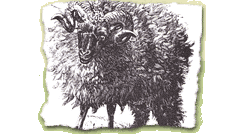

The Old Tup
Farm animals
Archival information
Lyrics
1
As I was going to Derby upon the market day,
I met the finest tup, sir, that ever was fed on hay.
Chorus
Bay-lee, bay-lee, reddy fol-oo-ra-lay.
2
This tup was fat behind, sir, this tup was fat before,
This tup stood eleven yards wide, sir, and I think he stood no more.
3
The horns that grew on his head, sir, they grew so mighty high,
That every time he nodded his head he nodded against the sky.
4
The very first tooth he had in his head would make a good huntsman’s horn,
The very next tooth to that, sir, would hold up a bushel of corn.
5
The wool that grew on his back, sir, it grew so mighty high,
That eagles built their nests, sir, and I heard the young ones cry.
6
The wool that grew on his belly, sir, it draggled along the ground,
That every foot that he put down, it covered an acre of ground.
7
The wool that grew on his tail, sir, it grew so long and soft,
They sent it down to Derby and it made six yards of cloth.
8
The butcher that killed this tup, sir, in danger of his life,
He called unto his servant to reach him a longer knife.
9
The blood that ran from this tup, sir, it run doon Derby Moor,
And turned the biggest watermill that’s ever been seen before.
10
And all the young lads in Derby came begging for his eyes,
To kick up and down old Derby’s streets for they were football size.
11
And all the young lasses in Derby came begging for his ears,
To make a pair of panniers to hawk apples and pears.
12
And all the old women in Derby came begging for his bones,
To suck the marrow out o’ them to nourish their old bones.
13
And now me song is ended and I cannot sing no more,
So please will you give me a Christmas box and let me on me way.
Archival information
This is a traditional song
Provenance
In its native area of north east Derbyshire and South Yorkshire the song forms part of a mummers play known locally as The Old Tup. It is usually performed by a group of adolescents during the Christmas season at public houses and working-men’s clubs. The characters are usually a man and his wife who introduce the play and the tup. One of them then calls for a butcher to kill the tup (ram). The butcher duly enters and there follows a dialogue in which the butcher asks how they want it killing. A tussle between the butcher and the tup ensues culminating in the death of the tup. The song is then sung. The texts of the play and the song can vary considerably from village to village and some versions even have incorporated extra characters, even some from other types of mummers plays, such as Little Devil Doubt.
Whether the song and the play originated at the same time or one preceded the other we will now never know. Even whether they had separate existences before they came together can not be ascertained. What we can say with some certainty is that the play was definitely centred in north east Derbyshire around Chesterfield in the nineteenth century and that during the twentieth century it thrived particularly in the area to the north and east of Chesterfield nowadays bounded by the A61 and the M1. It also spread northwards during the nineteenth century into South Yorkshire. Records and newspaper reports show that during the nineteenth century it was very popular in Sheffield itself and it even spread further north as far as Doncaster. (See Here comes me and our old lass, short of money and short of brass: A Survey of traditional Drama in North East Derbyshire 1970-78, by Ian Russell, Folk Music Journal Volume 3, Number 5, 1979)
This version of the song comes from the village of Barnburgh between Barnsley and Doncaster. A similar version from Thorpe Salvin can be seen in Paul Davenport’s excellent anthology The South Riding Songbook, 1998, p29
My grandmother, Annie Sykes, of Hull sang a very different version which she learnt from her aunt, a native of Sheffield, who sang it at parties when my grandmother was a child in the 1890s.
(See Gardham, An East Riding Songster, 1982, p5)

